Canadair CF-5
The Canadair CF-5 (officially designated the CF-116 Freedom Fighter) is a Canadian licensed-built Northrop F-5 Freedom Fighter, a light, supersonic, twin engine, daylight air superiority fighter primarily for the Canadian Forces (as the CF-5) and the Royal Netherlands Air Force (as the NF-5). The CF-5 was upgraded periodically throughout its service career in Canada. The Canadian Forces retired the aircraft in 1995, although the CF-5 continues to be used by other countries.
| CF-5/CF-116/NF-5 Freedom Fighter | |
|---|---|
_CF-116A_(CL-219)%252C_Canada_-_Air_Force_AN1952661.jpg.webp) | |
| Canadian Forces CF-5A Freedom Fighter on display on a stand at Trenton, Ontario | |
| Role | Fighter-bomber |
| Manufacturer | Canadair |
| First flight | 6 May 1968 |
| Introduction | 5 November 1968 |
| Status | Retired from Canadian service in 1995, still in service with some countries |
| Primary users | Canadian Forces (former) Royal Netherlands Air Force Venezuelan Air Force Turkish Air Force |
| Number built | 240 |
| Developed from | Northrop F-5 |
The CF-5 was ordered by the Royal Canadian Air Force, which became part of the Canadian Forces on 1 February 1968. The new unified force took delivery of the first CF-5s (it was almost universally referred to as the CF-5 except in official documentation[1]) at the end of 1968. Production by Canadair for the Canadian Forces was 89 single-seat aircraft, 46 dual-seat aircraft and 75 single-seat with 30 dual-seat aircraft for the Royal Netherlands Air Force, a total production of 240. Twenty surplus Canadian aircraft were sold to Venezuela.[2][3][4]
Design and development
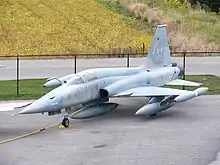
Originally designed by Northrop as a low-cost, low-maintenance fighter jet, the F-5 was intended for use by air forces that had limited resources and technical expertise to maintain a sophisticated aircraft. For Canada, which had an extensive aerospace industry, selection of the F-5 was seen as a step backwards. Selected originally to provide a tactical support role based in Canada, CF-5 squadrons were also committed to NATO's northern flank to act as a rapid-deployment force. However, the role for the CF-5 throughout its service with the RCAF was changed frequently and eventually, the diminutive fighter would serve as a light attack strike fighter, reconnaissance platform and trainer.[3]
Compared to the Northrop F-5, the Canadian CF-5 had several modifications to make it more suitable for operating in Canadian Forces theaters of operations. In order to address complaints about long takeoff runs, the Canadair version featured a two-position nose landing gear; compressed it operated like the original, but extended (before takeoff) it raised the nose and thereby increased the angle of attack and increased lift. The system reduced takeoff distance by almost 20%. A midair refueling probe was installed, Orenda-built General Electric J85-15 engines with 4,300 lbf (19 kN) thrust were used, and a more sophisticated navigation system was added. The nose of the CF-5 was also interchangeable with a specially designed reconnaissance set with four cameras in it. Over the course of its life, it received many upgrades to its avionics and capabilities.
An order for 105 aircraft for the Royal Netherlands Air Force was signed in early 1967, 75 single-seaters to replace the Republic F-84 and 30 twin-seaters to replace the Lockheed T-33. The plan to use some single-seaters for photo-reconnaissance to replace the Lockheed F-104G Starfighters never materialized. Production of the F-5 in Europe was originally planned by Fokker and SABCA, for the Dutch and Belgian Air Forces, but hesitancy by Belgium led to the Netherlands government ordering under a production sharing agreement with Canada.[5] As part of the production sharing agreement between the Canadian and Dutch governments the centre fuselages for all but the first 31 aircraft were built by Fokker in the Netherlands.[6]
The first CF-5 was formally rolled out in a ceremony at the Cartierville factory on 6 February 1968.[7] The first NF-5 was rolled out on 5 March 1969.[8]
Operational history
Canada
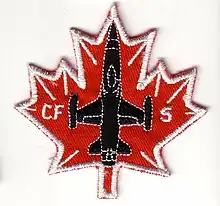
Initially 433 Squadron and 434 Squadron were the only two squadrons to operate the CF-5. It was intended that three squadrons would fly the aircraft, but due to budgetary restrictions, the excess aircraft were put into storage in CFB North Bay and CFB Trenton, some later being sold to other countries. 434 Squadron was assigned to do lead-in tactical fighter training for the Canadair CF-104 Starfighter, but was transitioned to the role of a rapid reaction squadron, being ready to deploy to Europe at short notice in the event of hostilities. The squadron moved to CFB Bagotville with 433 Squadron, for a short time, and then on to CFB Chatham.[3]
The training role was adopted by 419 Squadron at CFB Cold Lake; it would continue to provide jet training, dissimilar air combat training (painted in Soviet style "aggressor" schemes similar to USAF, USN and USMC F-5Es), and serve as a lead-in fighter trainer for the McDonnell Douglas CF-18 Hornet until retired in 1995. All remaining airframes were put into storage at CFD Mountain View.
While originally intended to be deployed to Europe, due to budgetary limitations the CF-5 became a rapid deployment reinforcement, to be deployed to central Europe or later Norway in time of war. CF-5s did deploy to Europe for several reasons many times during the Cold War: in 1970 six CF-5As deployed to CFB Baden–Soellingen in Germany, later flying to Norway in early 1971; in 1973 eight CF-5A and CF-5R flew to Norway; in 1974 four CF-5A and CF-5Rs participated in a NATO reconnaissance exercise at Leck, Germany; two Canadair CF-5R visited Leeuwarden, Netherlands in 1974; sixteen CF-5As flew to Europe in 1977; in 1978 eight CF-5As deployed to Norway to participate to NATO's Arctic Express exercise; in 1980 eight CF-5As participated in the Anorak Express exercise in Norway; in 1985 and 1986 CF-5As depolyed to NATO exercises (Brave Lion) in Norway, and finally, the last deployment to Europe was in 1987 when four CF-5As arrived at CFB Baden–Soellingen; in June, 1988 the CF-5A was replaced in the rapid deployment force by the McDonnell Douglas CF-18 Hornet.[9] Additionally, CF-5R photo reconnaissance aircraft participated in Best Focus exercises in Europe during 1978, 1980 and 1985, with a Canadian pilot winning the NATO "Photo Derby" in 1985.[9]
Netherlands
The Royal Netherlands Air Force took delivery of its first aircraft (an NF-5B two-seater) in October 1969, with the first squadron to be formed being 313 Squadron at Twente. The initial role of 313 Squadron was a conversion unit to train pilots on the new type. The NF-5 would serve with four operation squadrons, 313 and 315 Squadron at Twenthe, 316 Squadron at Gilze-Rijen and 314 Squadron at Eindhoven. The last NF-5 was delivered in March 1972.
From 1986 the squadrons began to convert to the licence-built General Dynamics F-16 and the last NF-5 was stood down in March 1991.
Most surplus aircraft were sold to Turkey (most to Turkish Stars) and Venezuela (mix CF-5A and CF-5D - 18 in 1972, 2 new CF-5D in 1974 and 7 ex-RNAF NF-5A/B in 1990; all served with Grupo de Caza 12) or retained for spares support.[10] A dozen aircraft were donated to Greece.
Variants
- CF-5A : Single-seat fighter version for the Canadian Forces, designation CF-116A. 89 built. 13 sold to Botswana and 16 sold to Venezuela.
- CF-5A(R) : Single-seat reconnaissance version for the Canadian Forces. 50 interchangeable camera noses built to swap the CF-5A's twin 20mm cannon nose with a quad 70mm Vinten camera nose. Canadian Forces provisional designation CF-116A(R).[3]
- CF-5D : Two-seat training version for the Canadian Forces, CF-116D. 46 built. 5 sold to Botswana and 4 sold to Venezuela.
- NF-5A : Single-seat fighter version for the Royal Netherlands Air Force. 75 built. 1 sold to Venezuela and 10 donated to Greece.
- NF-5B : Two-seat training version for the Royal Netherlands Air Force. 30 built. 6 sold to Venezuela and 2 donated to Greece.
- VF-5A : Single-seat fighter version sold to Venezuelan Air Force.
- VF-5D : Two-seat training version sold to Venezuelan Air Force.
Operators
.jpg.webp)
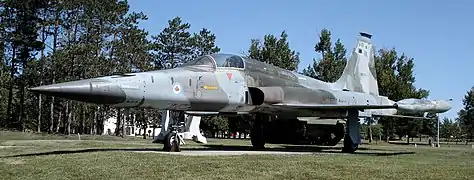
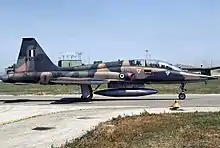
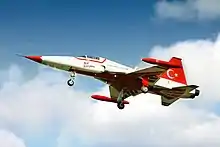
_VF-5A_(CL-226)_Schleiffert-1.jpg.webp)
- Botswana Air Force[3]
- Total of 18 ex-Canadian fighters delivered in 1996 and 2000; (13 CF-5A and 5 CF-5D). All assigned at Z28 Squadron and stationed Maparangwane Air Base.[11] 11 CF-5A and 4 CF-5D were still in use as of 2021.[12]
- Turkish Air Force
- 19 NF-5A/B 2000 Freedom Fighters were in service as of 2021, used as trainers and flying with 133rd Aerobatic Squadron Turkish Stars.[13]
- Tactical Air Support, Inc.
- In 2013, the company added four Canadair CF-5D Freedom Fighters and 20 years' worth of spare F-5 parts to its fleet.[14]
- Venezuelan Air Force[3]
- Air Group 12 - 6 CF-5A in use as of 2021.[15]
Former operators
- Canadian Forces Air Command
- Aerospace Engineering Test Establishment[3]
- 8 CF-5D aircraft assigned to AETE from 1968 to 1996
- Sale of 28 used Canadian CF-5 offered to Greece, for $75 million, in 2001 was unsuccessful and the aircraft were used for avionics training and the spare parts were scrapped.[16]
- Hellenic Air Force
- 12 NF-5s (10 NF-5As, one NF-5B and one NF-5B for spares) were donated by the Netherlands to Greece in 1991 for use with 349 "Kronos" Squadron. They were withdrawn in 2001.[17]
- Royal Netherlands Air Force[3] 105 NF-5 (75 single and 30 dual seaters) were introduced into service between 1969 and 1972, decommissioned in 1991
- No. 313 Squadron; Twente Air Base (transitioned to F-16 in 1987)
- No. 314 Squadron; Eindhoven Air Base (transitioned to F-16 in 1990)
- No. 315 Squadron, Operation Conversion Unit (OCU); Twente Air Base (transitioned to F-16 in 1986)
- No. 316 Squadron; Gilze-Rijen Air Base (transitioned to F-16 in 1991)
- Field Technic Training Unit NF-5 (1971–1984); Twente Air Base
Aircraft on display

.jpg.webp)
- Air Force Heritage Museum and Air Park, Winnipeg, Manitoba[18]
- Atlantic Canada Aviation Museum[19]
- Canada Aviation and Space Museum, Ottawa, Ontario[20]
- Canadian War Museum Ottawa, Ontario – reconnaissance version[21]
- Canadian Warplane Heritage Museum in Hamilton, Ontario[22]
- Cold Lake Air Force Museum[23]
- CFB Cold Lake - CF-5A '116736' mounted on a pole near the base entrance.[24]
- Defence Research and Development Canada – Toronto (DRDC) (mounted on Sheppard Avenue West), Toronto, Ontario[25]
- Kamloops Airport[26]
- Memorial Military Museum in Campbellford, Ontario (s/n 116730).[27][28]
- National Air Force Museum of Canada, Trenton, Ontario[29]
- Reynolds-Alberta Museum, Wetaskiwin, Alberta[30]
- The Military Museums Calgary, Alberta[31]
- Toronto/Markham Airport 2 located at Markham, Ontario[32]
Europe
- NF-5A 'K-3003' on display at Gilze-Rijen Air Base, the Netherlands[33]
- NF-5A 'K-3020' on display at Nationaal Militair Museum, former Soesterberg Air Base, the Netherlands[34]
- NF-5A 'K-3068' on display at Eindhoven Air Base, the Netherlands[35]
- NF-5B 'K-4011' in storage at Nationaal Militair Museum, former Soesterberg Air Base, the Netherlands.[36]
- NF-5B 'K-4012' as instructional airframe at Deltion College Zwolle, the Netherlands[37]
Specifications (CF-116)

General characteristics
- Crew: one–two
- Length: 47 ft 2 in (14.38 m)
- Wingspan: 25 ft 10 in (7.87 m)
- Height: 13 ft 2 in (4.01 m)
- Wing area: 186 sq ft (17.28 m2)
- Empty weight: 8,681 lb (3,938 kg)
- Max takeoff weight: 20,390 lb (9,249 kg)
- Powerplant: 2 × Orenda-built GE J85-15 turbojet, 2,925 lbf (13.01 kN) thrust each dry, 4,300 lbf (19 kN) with afterburner
Performance
- Maximum speed: 978 mph (1,575 km/h, 850 kn) [38]
- Maximum speed: Mach 1.3
- Range: 875 mi (1,400 km, 760 nmi)
- Service ceiling: 41,000 ft (12,000 m)
- Rate of climb: 34,400 ft/min (175 m/s)
Armament
- Guns: 2× 20 mm (0.787 in) Pontiac M39A2 cannons in the nose, 280 rounds/gun
- Hardpoints: 5 with a capacity of 7,000 lb (3,200 kg), with provisions to carry combinations of:
- Rockets: 2× CRV7 rocket pods
or 2× LAU-10 rocket pods with 4× Zuni 127 mm rockets each
or 2× Matra rocket pods with 18× 68 mm SNEB rockets each - Bombs: a variety of air-to-ground ordnance, such as the Mark 80 series of unguided iron bombs (including 3 kg and 14 kg practice bombs), U.S. CBU-24/49/52/58 and British BL755 cluster bomb munitions, M129 Leaflet bomb
- Other: drop tanks for extended range
- Rockets: 2× CRV7 rocket pods
- Missiles: 2× AIM-9 Sidewinder air-to-air missiles
See also
Related development
Aircraft of comparable role, configuration, and era
Related lists
References
Notes
- Canadian Armed Forces (5 March 2010). "Historical Aircraft". Archived from the original on 5 December 2010. Retrieved 28 May 2016.
- CF-5 with Venezuela
- Aeroware (2012). "Canadair CF-116 CF-5". canadianwings.com. Archived from the original on 13 April 2014. Retrieved 28 May 2016.
- Canadian Armed Forces (6 April 2004). "Canadair CF-5 Freedom Fighter". Archived from the original on 5 December 2010. Retrieved 28 May 2016.
- "Canadian F-5s for RNAF". Flight International. 91 (3022): 223. 9 February 1967.
- "Canadair's CF-5 Production". Flight International. 94 (3113): 759. 7 November 1968.
- "Defence". Flight International. 93 (3076): 280. 22 February 1968.
- "Photo caption". Flight International. Iliffe. 95 (3133): 459. 20 March 1969.
- Canadair CF-5 Canadian Profile, (Aircraft No 4) by Bob McIntyre, SMS Publishing, Ottawa, 1985 (ISBN 0-920375-02-2) pp.34-43, 47
- "CF-5 with Venezuela". www.joebaugher.com.
- "Botswana Defence Force". Scramble.nl. Archived from the original on 20 January 2012. Retrieved 9 July 2012.
- World Aircraft Directory, 2022 (FlightGlobal, part of DVV Media International Ltd, 2021) p. 14.
- World Aircraft Directory, 2022 (FlightGlobal, part of DVV Media International Ltd, 2021) p. 31.
- Gallop, Gerry (5 March 2013). "Launch of F-5 Parts Sales Enterprise". Tactical Air Support Inc. Retrieved 22 September 2015.
- World Aircraft Directory, 2022 (FlightGlobal, part of DVV Media International Ltd, 2021) p. 34.
- Ottawa, The (22 April 2006). "Forces to scrap jet parts worth $200M". Canada.com. Archived from the original on 25 June 2014. Retrieved 9 July 2012.
- "Hellenic Air Force Historical Aircraft". HAF Official website. Archived from the original on 4 March 2016. Retrieved 23 February 2019.
- Goldsborough, Gordon. "Historic Sites of Manitoba: Air Force Heritage Museum and Air Park (Air Force Way, Winnipeg)". www.mhs.mb.ca. Retrieved 5 October 2018.
- Atlantic Canada Aviation Museum. "Canadair (Northrop) CF-5 Freedom Fighter". Atlanticcanadaaviationmuseum.com. Retrieved 10 August 2013.
- Canada Aviation and Space Museum (n.d.). "Canadair CF-116 (CF-5A)". Archived from the original on 1 January 2013. Retrieved 14 October 2012.
- Canadian War Museum, Where People and History Come To Life Archived 13 August 2013 at the Wayback Machine, dated 2003-4, retrieved 10 August 2013
- Canadian Warplane Heritage Museum. "Northrop CF-5A Freedom Fighter Vintage Fighter Aircraft". Warplane.com. Retrieved 10 August 2013.
- "Cold Lake Museum – F5". Retrieved 21 February 2017.
- "Wrecks and relics online - Aircaft wreck or relic at Cold Lake, Alberta, Canada".
- Kenter, Peter (2012). "Steel key for CF-5 fighter jet monument at Toronto defence facility". Daily Commercial News. Reed Business Information. Archived from the original on 25 March 2014.
- Boyko, Steve. "On laughter-silvered wings." Flickr, 12 November 2012.
- Memorial Military Museum
- AVROLAND Memorial Military Museum - Campbellford
- "Aircraft – National Air Force Museum of Canada". Airforcemuseum.ca. Retrieved 10 August 2013.
- "Aviation". Reynolds Museum. Government of Alberta. Retrieved 1 December 2019.
- The Military Museums (2020). "CF-5". themilitarymuseums.ca. Archived from the original on 3 August 2020. Retrieved 4 August 2020.
- Henniger. "Feature: Canadian Air, Land and Sea Museum." .webshots.com, August 2005. Retrieved: 27 January 2010.
- "Spottingmode.com Wrecks and Relics".
- Van Gent, C.J. De Northrop NF-5: De historie van de NF-5 bij de Koninklijke Luchtmacht.
- "Spottingmode.com Wrecks and Relics".
- "Northrop NF-5B 'Freedom Fighter' jachtbommenwerper / trainer met registratienummer K-4011 (in Dutch)".
- "Spottingmode.com Wrecks and Relics".
- "Canadair (Northrop) CF-5 Freedom Fighter." ednet.ns.ca. Retrieved: 23 July 2011.
Bibliography
- McIntyre, Bob. Canadair CF-5 (Canadian Profile: Aircraft No. 4). Ottawa, Ontario: Sabre Model Supplies Ltd., 1985. ISBN 0-920375-02-2.
- Pickler, Ron and Larry Milberry. Canadair: the First 50 Years. Toronto: CANAV Books, 1995. ISBN 0-921022-07-7.
- Stachiw, Anthony L. Canadair CF-5 Freedom Fighter (Canadian Service Aircraft No.1). St. Catharine's, Ontario: Vanwell Publishing, 2003. ISBN 1-55125-073-X.
- Van Gent, C.J. De Northrop NF-5: De geschiedenis van de NF-5 in Nederland. Alkmaar, Netherlands: Uitgeverij De Alk, 1992. ISBN 90-6013-518-0.
- Van Gent, C.J. De Northrop NF-5: De historie van de NF-5 bij de Koninklijke Luchtmacht. Odoorn, Netherlands: Uitgeverij Lanasta, 2020. ISBN 978-90-8616-179-9.
- Van Gent C.J. De Starfighter: De geschiedenis van de Starfighter in Nederland. Maarssen, Netherlands: Uitgeverij Geromy, 2012. ISBN 9789081893619.
External links
- CF-5 (CF-116) Freedom Fighter – Atlantic Canada Aviation Museum